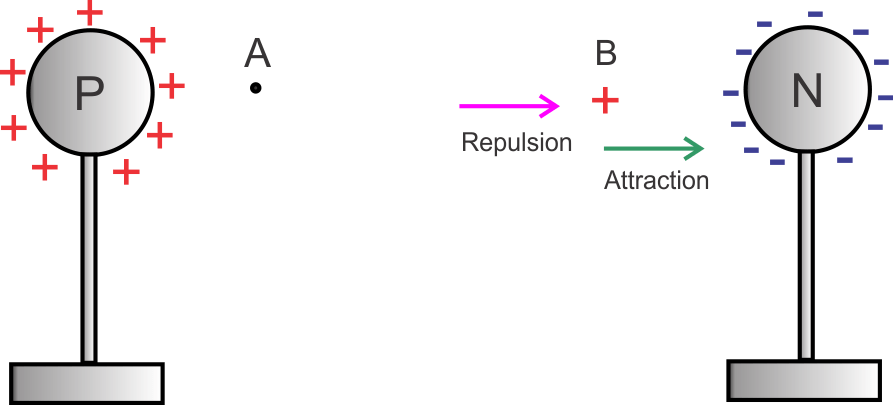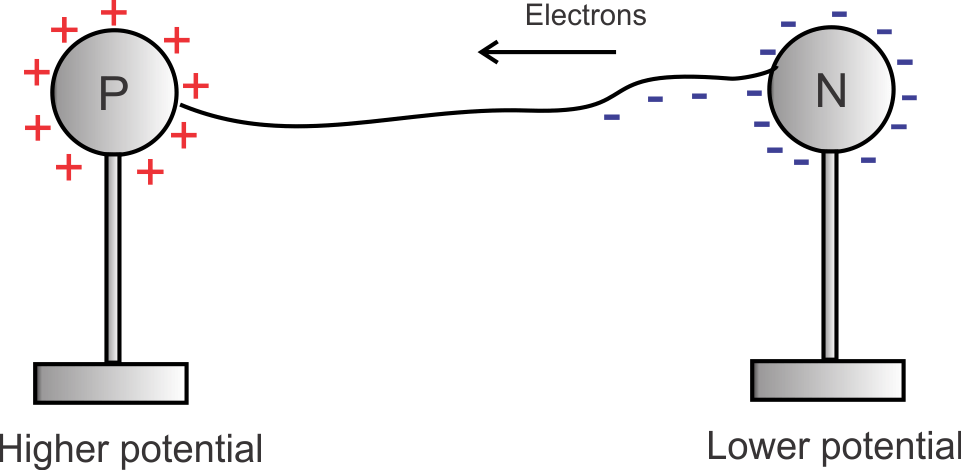The flow of charge in an electric circuit signifies the existence of electric current in that circuit. We can define electric current as the rate of flow of electric charges (electrons) in a conductor (for example copper or metallic wire).
Flow of charge definition
The flow of charge is the process of supplying or adding electric charge to an object or losing electric charge (mainly electrons) from an object.
Explaination
Consider two identical metallic spheres \(P\) and \(N\), carrying an equal amount of positive and negative charges as shown in this figure.
Learn more about electric charge.

Now we want to take a positive charge from point \(B\) to point \(A\). We already know that unlike charges attract each other and like charges repel each other. So, this positive charge is attracted by the negatively charged sphere \(N\) and repelled by the positively charged sphere \(P\).
Here our goal is to move this positive charge from point \(B\) to \(A\). So, to move the charge towards point \(A\), you would have to apply the force on this charge towards the left. This is because this positive charge is repelled by sphere \(P\).
Now you might remember this from class 9 physics that work is said to be done when a force produces motion. Here also the force you are applying on positive charge towards left results in the motion of charge towards left.
Since force applied on the charge displaces it in the direction of the application of force, the work done is positive. Hence the potential difference \(V_A-V_B\) between points A and B is positive. And from this, we can conclude that VA>VB
Know more about force and laws of motion
Now as you move towards \(P\), the work done increases, so the potential also increases. Now here work done increases because positive charge on \(P\) is opposing the motion of charge towards point \(A\). Again if you move towards \(N\) the potential decreases. Why does this happen? Think yourself to find an answer. So, we can see the potential of \(P\) is greater then that of \(N\). In the general potential of a positively charged body is taken as higher than that of a negatively charged body.
The flow of charge direction
Now a question arises what happens when a free to move charge is placed between these two spheres. In such a case, a positive charge will move towards the negatively charged sphere and a negative charge will move towards the positively charged sphere. Or we can say that a free positive charge will move towards lower potential and a free negative charge will move towards higher potential.
The flow of charges inside a wire
Let us now connect these two metal spheres by a metal wire as shown in the figure given below to explore how the flow of charges inside wire takes place.

After the connection is being made, electrons from the negatively charged sphere which is at lower potential will begin to flow towards the positively charged sphere which is at a higher potential. Again a question arises how long does this flow of charge take place. Can this go on infinitely? The answer is no. The flow of charges will not takes place infinitely in this arrangement. Eventually, the flow of electrons will balance out the number of charges on both the spheres.
This means at this point both the spheres have an equal amount of charges on them and both of them are at the same potential. And this is the point where the flow of electrons stops. So, we can say that potential difference causes the charges to flow. Hence as long as there is a potential difference between two ends of a conductor charges will flow in the conductor.
Video Explanation of the flow of charge
Further References
1. http://hyperphysics.phy-astr.gsu.edu/hbase/electric/elecur.html
2. https://physics.info/electric-current/
 Skip to content
Skip to content